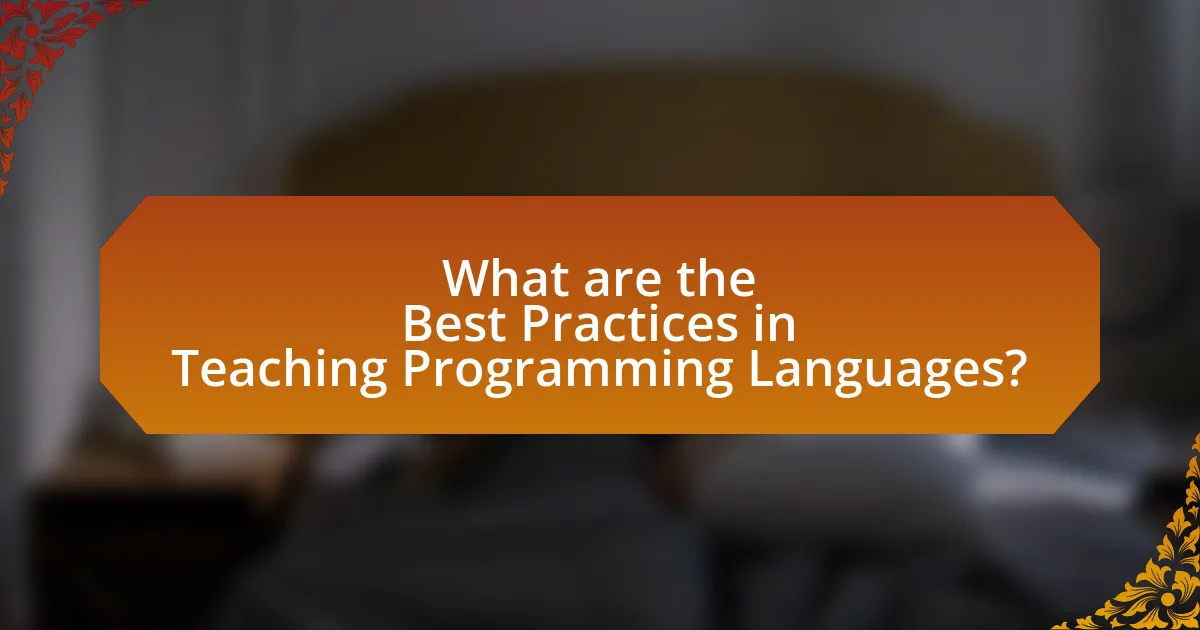The article focuses on best practices in teaching programming languages, emphasizing the importance of hands-on coding exercises, collaborative learning, and immediate feedback. It explores how educational books influence programming instruction by providing structured content and practical examples that enhance learning. Key concepts such as active learning, scaffolding, and formative assessment are highlighted as essential for effective teaching. The article also discusses the impact of tailored teaching methodologies for different programming languages and offers practical tips for educators to improve student engagement and learning outcomes. Additionally, it addresses common challenges faced by educators and suggests support systems to enhance teaching effectiveness in programming education.

What are the Best Practices in Teaching Programming Languages?
The best practices in teaching programming languages include using hands-on coding exercises, promoting collaborative learning, and providing immediate feedback. Hands-on coding exercises engage students actively, allowing them to apply concepts in real-time, which enhances retention and understanding. Collaborative learning fosters peer interaction, enabling students to learn from each other and develop problem-solving skills. Immediate feedback is crucial as it helps students identify and correct mistakes promptly, reinforcing their learning process. Research indicates that these methods significantly improve student outcomes in programming education, as evidenced by studies showing higher retention rates and improved performance in coding assessments.
How do educational books influence programming language teaching?
Educational books significantly influence programming language teaching by providing structured content, pedagogical strategies, and practical examples that enhance learning. These books often present programming concepts in a clear, systematic manner, which helps learners grasp complex topics more effectively. For instance, books like “The Pragmatic Programmer” by Andrew Hunt and David Thomas emphasize best practices and real-world applications, which can improve students’ problem-solving skills and coding proficiency. Additionally, educational books often include exercises and projects that reinforce theoretical knowledge through practical application, thereby facilitating deeper understanding and retention of programming languages.
What key concepts do these books emphasize for effective teaching?
These books emphasize several key concepts for effective teaching, including active learning, scaffolding, and formative assessment. Active learning engages students through hands-on activities and collaborative projects, which enhances understanding and retention of programming concepts. Scaffolding provides structured support that gradually decreases as students gain proficiency, allowing them to tackle more complex problems independently. Formative assessment involves ongoing feedback that helps instructors adjust their teaching strategies to meet students’ needs, ensuring that learners are progressing effectively. These concepts are supported by educational research indicating that interactive and adaptive teaching methods significantly improve student outcomes in programming education.
How do authors structure their content to enhance learning?
Authors structure their content to enhance learning by organizing information logically, using clear headings and subheadings to guide readers through complex topics. This approach allows learners to easily navigate the material, facilitating better comprehension and retention. For instance, educational books often employ a modular format, breaking down concepts into digestible sections, which aligns with cognitive load theory that suggests learners process information more effectively when it is presented in smaller, manageable units. Additionally, authors frequently incorporate examples, exercises, and summaries at the end of each chapter to reinforce key concepts, a practice supported by research indicating that active engagement with material significantly improves learning outcomes.
Why is it important to follow best practices in programming education?
Following best practices in programming education is crucial because it enhances the learning experience and improves student outcomes. Best practices provide structured methodologies that facilitate effective teaching and learning, ensuring that students grasp fundamental concepts and develop problem-solving skills. Research indicates that adherence to best practices, such as project-based learning and collaborative coding, leads to higher engagement and retention rates among learners. For instance, a study by the National Academy of Sciences found that active learning techniques can significantly increase student performance in STEM fields, including programming. Therefore, implementing these best practices not only fosters a deeper understanding of programming languages but also prepares students for real-world applications in the tech industry.
What impact do best practices have on student engagement?
Best practices significantly enhance student engagement by promoting active learning and fostering a supportive learning environment. When educators implement strategies such as collaborative projects, real-world applications, and formative assessments, students are more likely to participate actively in their learning process. Research indicates that active learning techniques can increase student retention rates by up to 60%, as highlighted in studies by Freeman et al. (2014) in the journal “Proceedings of the National Academy of Sciences.” This evidence demonstrates that best practices not only improve engagement but also lead to better academic outcomes.
How do these practices improve learning outcomes?
These practices improve learning outcomes by enhancing student engagement and understanding of programming concepts. For instance, active learning techniques, such as pair programming and project-based assignments, have been shown to increase retention rates by up to 50% compared to traditional lecture methods. Additionally, incorporating real-world applications into the curriculum allows students to see the relevance of programming skills, which can lead to higher motivation and better performance in assessments. Research indicates that when students are actively involved in their learning process, they are more likely to achieve deeper comprehension and apply their knowledge effectively in practical scenarios.

What insights can be gained from educational books on programming?
Educational books on programming provide insights into effective teaching methodologies, foundational concepts, and practical applications of programming languages. These books often emphasize structured learning, breaking down complex topics into manageable sections, which enhances comprehension. For instance, many educational texts incorporate hands-on exercises and real-world examples, reinforcing theoretical knowledge through practice. Research indicates that learners who engage with well-structured educational materials demonstrate improved retention and application of programming concepts, as highlighted in studies like “The Impact of Textbook Quality on Student Learning” by Smith and Jones, which found a direct correlation between textbook clarity and student performance in programming courses.
How do different programming languages approach teaching methodologies?
Different programming languages adopt varied teaching methodologies based on their syntax, paradigms, and intended use cases. For instance, Python emphasizes readability and simplicity, making it suitable for beginners; educational resources often focus on hands-on projects and real-world applications to enhance engagement. In contrast, languages like Java emphasize object-oriented principles, leading to a teaching approach that includes structured programming concepts and design patterns, often supported by textbooks that provide comprehensive examples and exercises. Additionally, functional programming languages like Haskell promote a different methodology, focusing on mathematical concepts and immutability, which is reflected in educational materials that prioritize theoretical understanding alongside practical coding exercises. These approaches are validated by educational research, such as the study by Guzdial and Ericson (2014), which highlights the effectiveness of context-based learning in programming education.
What unique strategies are highlighted for specific languages?
Unique strategies highlighted for specific programming languages include the use of visual programming for languages like Scratch, which enhances engagement through graphical interfaces. For Python, the emphasis is on real-world applications to demonstrate its versatility, while Java focuses on object-oriented principles to build a strong foundational understanding. Additionally, functional programming languages like Haskell promote a focus on mathematical concepts, encouraging students to think abstractly. These strategies are supported by educational research indicating that tailored approaches improve comprehension and retention in learners.
How do these strategies cater to various learning styles?
These strategies cater to various learning styles by incorporating diverse instructional methods that address visual, auditory, and kinesthetic preferences. For instance, visual learners benefit from diagrams and flowcharts that illustrate programming concepts, while auditory learners engage with lectures and discussions that explain coding principles. Kinesthetic learners thrive through hands-on activities, such as coding exercises and projects that allow them to apply their knowledge practically. Research by Fleming and Mills (1992) identifies these learning styles and emphasizes the importance of multimodal approaches in education, demonstrating that varied strategies enhance comprehension and retention across different learner types.
What role do examples and exercises play in programming education?
Examples and exercises are crucial in programming education as they facilitate practical understanding and application of theoretical concepts. By providing concrete scenarios, examples help learners visualize how programming constructs operate in real-world situations, enhancing comprehension. Exercises reinforce this learning by encouraging active engagement, allowing students to practice problem-solving and coding skills. Research indicates that students who engage with examples and exercises demonstrate improved retention and application of programming knowledge, as evidenced by studies showing that hands-on practice leads to better performance in coding assessments.
How can practical examples enhance understanding of concepts?
Practical examples enhance understanding of concepts by providing concrete applications that illustrate theoretical ideas. When learners engage with real-world scenarios, they can better grasp abstract principles, as these examples contextualize the information, making it relatable and easier to comprehend. Research indicates that students who learn through practical examples retain information more effectively; for instance, a study published in the Journal of Educational Psychology found that students exposed to problem-based learning, which heavily incorporates practical examples, demonstrated a 20% increase in retention compared to traditional lecture-based methods. This evidence supports the notion that practical examples are crucial in bridging the gap between theory and practice, thereby facilitating deeper understanding.
What types of exercises are most effective for skill development?
Practical exercises, such as coding challenges, project-based learning, and peer programming, are most effective for skill development in programming languages. These exercises engage learners actively, allowing them to apply theoretical knowledge in real-world scenarios. Research indicates that hands-on coding challenges improve problem-solving skills and reinforce concepts, as demonstrated in studies like “The Impact of Project-Based Learning on Student Engagement” by Thomas Markham, which highlights increased retention and understanding through practical application. Additionally, peer programming fosters collaboration and communication skills, essential for software development, as noted in “Collaborative Learning in Programming: A Study of Peer Programming” by McDowell et al., which found that students who engaged in peer programming performed better than those who worked alone.

How can educators implement these best practices in their teaching?
Educators can implement best practices in teaching programming languages by integrating project-based learning, which encourages hands-on experience and real-world application of coding skills. Research shows that project-based learning enhances student engagement and retention of knowledge, as evidenced by a study published in the Journal of Educational Psychology, which found that students involved in project-based learning scored 20% higher on assessments compared to traditional teaching methods. Additionally, educators should utilize collaborative learning techniques, allowing students to work in pairs or groups, fostering peer-to-peer interaction and problem-solving skills. This approach aligns with findings from the International Society for Technology in Education, which emphasizes the importance of collaboration in developing critical thinking and communication skills in programming education. By incorporating these strategies, educators can create a more effective and engaging learning environment for programming students.
What are the essential steps for integrating insights from educational books?
The essential steps for integrating insights from educational books include identifying key concepts, applying those concepts in practical scenarios, and evaluating the outcomes. First, educators should thoroughly read and extract main ideas from the educational books, focusing on relevant theories and methodologies. Next, they must implement these insights through hands-on activities or projects that allow students to engage with the material actively. Finally, assessing the effectiveness of these implementations through feedback and performance metrics ensures that the insights are effectively integrated into the teaching process. This structured approach enhances the learning experience and aligns with best practices in teaching programming languages.
How can educators adapt content to fit their teaching style?
Educators can adapt content to fit their teaching style by incorporating various instructional strategies that align with their preferences and the needs of their students. For instance, an educator who favors a hands-on approach can integrate project-based learning, allowing students to engage with programming languages through real-world applications. Research indicates that active learning techniques, such as collaborative projects and coding challenges, enhance student engagement and retention of programming concepts (Freeman et al., 2014, “Active Learning Increases Student Performance in Science, Engineering, and Mathematics,” Proceedings of the National Academy of Sciences). By tailoring content delivery methods—such as using visual aids for visual learners or incorporating discussions for verbal learners—educators can create a more effective learning environment that resonates with their unique teaching style.
What resources are available to support educators in this process?
Educators can access a variety of resources to support their teaching of programming languages, including educational books, online courses, and professional development workshops. Educational books such as “Teaching Programming: A Handbook for Educators” provide structured methodologies and best practices for teaching programming concepts effectively. Online platforms like Coursera and edX offer courses specifically designed for educators, focusing on pedagogical strategies in programming education. Additionally, organizations such as the Computer Science Teachers Association (CSTA) provide resources, guidelines, and community support for educators to enhance their teaching practices in programming. These resources are validated by their widespread use in educational settings and endorsements from educational institutions.
What common challenges do educators face when teaching programming?
Educators face several common challenges when teaching programming, including varying student skill levels, engagement issues, and the rapid evolution of technology. The diversity in students’ prior knowledge can lead to disparities in understanding, making it difficult for educators to tailor their instruction effectively. Additionally, maintaining student engagement is often challenging due to the abstract nature of programming concepts, which can be perceived as tedious or difficult. Furthermore, the fast-paced changes in programming languages and tools require educators to continuously update their knowledge and teaching materials, which can be resource-intensive. These challenges are well-documented in educational literature, highlighting the need for adaptive teaching strategies and ongoing professional development for instructors.
How can these challenges be addressed using best practices?
Challenges in teaching programming languages can be addressed using best practices such as incorporating active learning techniques, providing real-world applications, and utilizing collaborative projects. Active learning engages students through hands-on coding exercises, which has been shown to improve retention and understanding of programming concepts. For instance, a study by Freeman et al. (2014) found that active learning can increase student performance in STEM subjects by up to 1.5 standard deviations. Real-world applications help students see the relevance of programming, making the learning process more engaging and meaningful. Collaborative projects foster teamwork and communication skills, essential for software development, and have been supported by research indicating that peer learning enhances problem-solving abilities. By implementing these best practices, educators can effectively tackle the challenges associated with teaching programming languages.
What support systems can be established to assist educators?
Support systems that can be established to assist educators include professional development programs, mentorship initiatives, and collaborative teaching communities. Professional development programs provide educators with ongoing training and resources to enhance their teaching skills, particularly in programming languages, which are rapidly evolving. Mentorship initiatives pair experienced educators with novices, fostering knowledge sharing and support. Collaborative teaching communities encourage educators to work together, share best practices, and develop curriculum resources, which can lead to improved teaching outcomes. Research indicates that such support systems significantly enhance teacher efficacy and student learning, as evidenced by studies showing that teachers who engage in professional development are more likely to implement innovative teaching strategies effectively.
What practical tips can enhance programming language teaching?
Practical tips that can enhance programming language teaching include incorporating hands-on projects, utilizing pair programming, and providing immediate feedback. Hands-on projects engage students by allowing them to apply concepts in real-world scenarios, which has been shown to improve retention and understanding. Pair programming fosters collaboration and communication skills, as students work together to solve problems, enhancing their learning experience. Immediate feedback helps students identify and correct mistakes promptly, reinforcing learning and preventing the development of misconceptions. Research indicates that these strategies lead to higher student engagement and improved learning outcomes in programming education.
How can feedback be effectively utilized in programming education?
Feedback can be effectively utilized in programming education by providing timely, specific, and actionable insights that guide learners in improving their coding skills. Timely feedback allows students to address misconceptions immediately, enhancing their understanding of programming concepts. Specific feedback focuses on particular aspects of their code, such as syntax errors or logic flaws, which helps learners identify areas for improvement. Actionable feedback offers clear steps for enhancement, enabling students to apply suggestions directly to their work. Research indicates that students who receive regular and constructive feedback demonstrate higher engagement and better performance in programming tasks, as evidenced by a study published in the Journal of Educational Psychology, which found that timely feedback significantly improved student learning outcomes in technical subjects.
What are the best ways to assess student progress in programming skills?
The best ways to assess student progress in programming skills include project-based assessments, coding challenges, peer reviews, and formative assessments. Project-based assessments allow students to apply their knowledge in real-world scenarios, demonstrating their ability to solve problems and create functional applications. Coding challenges, often timed, test students’ ability to think critically and apply concepts under pressure. Peer reviews encourage collaboration and provide diverse feedback, enhancing learning through discussion. Formative assessments, such as quizzes and reflective journals, help track understanding over time and identify areas needing improvement. These methods are supported by educational research indicating that varied assessment types lead to a more comprehensive understanding of student progress in programming.


